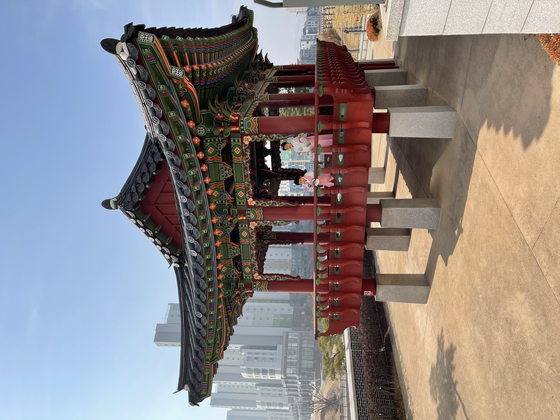The Beauty of Korea Illuminated in Hanbok [Photo Essay Contest]
Published: 08 Dec. 2023, 10:37
Updated: 08 Dec. 2023, 15:09

The Korea JoongAng Daily hosted its first photo essay contest for elementary, middle and high school students on the theme: “Promote the beauty of Korea to foreign countries." The contest ran from October to November. Photos containing scenes of traditional culture, family love, places to see and tasty treats in Korea were submitted for the contest.
Joelle Eun-Jae Kim from Seoul International School won the participation prize in the elementary school category for this photo essay.
Long before Seoul emerged as a global hub of beauty, the aesthetics of K-beauty can be traced back to the traditional clothes called hanbok. The legacy of hanbok can be traced back to the earliest history of Korea; and, this is the beauty of hanbok. This beauty is deeply interwoven with the people of Korea and its history. Rightfully, hanbok embodies both the rich cultural heritage and the traditions of Korea.
This beautiful dress is intricately woven using four main textile fabrics: silk, hemp, ramie, and cotton. The most amazing thing about hanbok is that while the style may have evolved over the years, the design has been preserved for over two thousand years. The origin of hanbok can be traced back to Goguryeo period (37 BC - 668 AD), which was one of the three kingdoms that fought for hegemony over the Korean peninsula. It is not surprising that hanbok originated at this time, as many artistic and cultural artifacts flourished during this period. Initially, people wore pure white hanbok as their daily attire. For weddings and other special occasions, hanbok was adorned with ornate designs. Hanbok is designed to have two parts. While women usually wear a dress, men wear loose fitting trousers to complement the top, called jeogori. In the past, the different styles of hanbok showed one’s social class. Upper class people wore more ornate hanbok while working class people wore plain cotton hanbok. Even though hanbok may appear to be tough to wear because of its many layers, it is actually quite the opposite. Hanbok is sewn in a way that flows with the individual’s body. People can feel comfortable wearing hanbok at the same time looking graceful and elegant. Because of this, many Koreans still revel in wearing this stunning and spectacular piece of art.
Since the beginning, Korean women have adorned their hair and faces with make-up when they wore hanbok. One way women further enhanced their elegance was through incorporating other fashion items like daenggi, a traditional Korean ribbon tied at the end of a braided hair, or binyeo, a pin made of wood, jade, or gold to hold a hair bun together. Women also espoused natural and clear make-up to embellish their dress. They applied make-up to bolster lighter skin tone with a tint of peach color blush. On their wedding day, women wore yeonji on their cheeks and gonji on their foreheads. They also applied safflower to highlight their lips in red. Korean women have been very much into beauty fashion since the beginning of time.
The beauty of hanbok has been recognized globally since the 1990s. Young Hee Lee, a respected hanbok designer, illuminated the Paris fashion world by featuring her collection at the Musée de l’Orangerie with her exhibition, “Hanbok: Clothes of the Wind”. Additionally, her design was featured in France’s prestigious prêt-à-porter collection. Slowly, hanbok began to take on the limelight in the global fashion. Since the 1990s, it has been featured continuously in international haute couture. During the Paris Fashion week in 2015, a prominent designer for Chanel, Karl Lagerfeld, dressed Korean models in hanbok inspired clothes. In 2017, the Republic of Korea’s Ministry of Culture, Sports and Tourism and the Hanbok Advancement Center partnered with an internationally acclaimed fashion designer, Carolina Herrera, to collaborate on a new collection of hanbok design. Since then, hanbok has been worn by other celebrities, such as Britney Spears, Jessica Alba, Lisa Ling, Sandra Oh, Venus Williams, and Hines Ward.
Hanbok is an embodiment of tradition and modernism. It has withstood many centuries of social and political changes. The style of hanbok has evolved to fit with the transformation of the country and its people. The global recognition also speaks to Korea’s solid position in the world. In essence, this is the true beauty of Korea.
By Joelle Eun-Jae Kim, Seoul International School










with the Korea JoongAng Daily
To write comments, please log in to one of the accounts.
Standards Board Policy (0/250자)